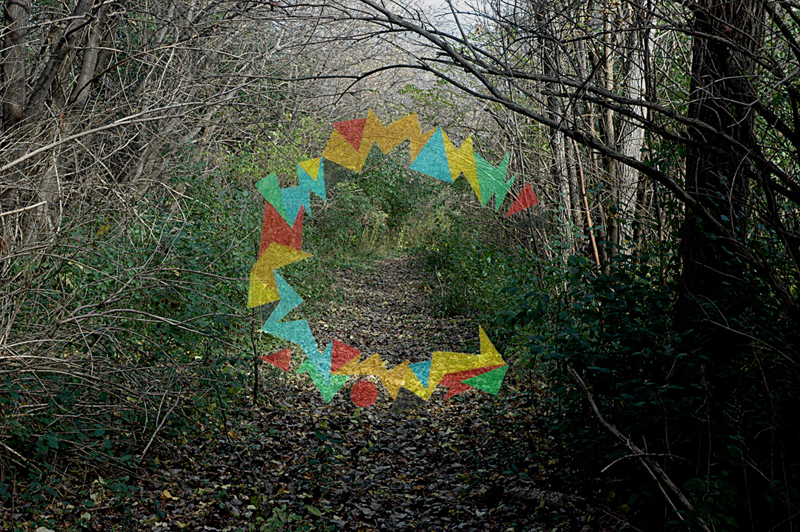Above, and below:
Artist's renderings of ocular arrays
superimposed over various landscapes. 

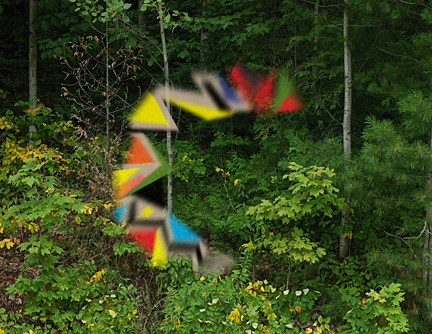
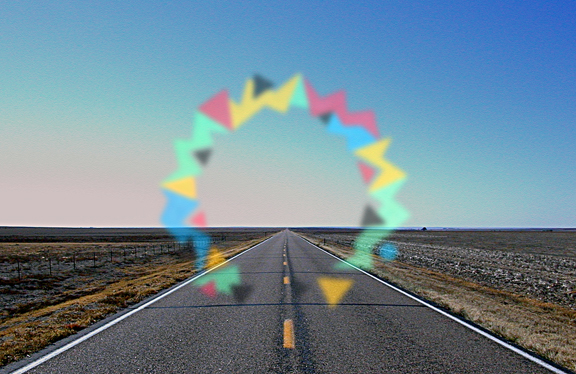
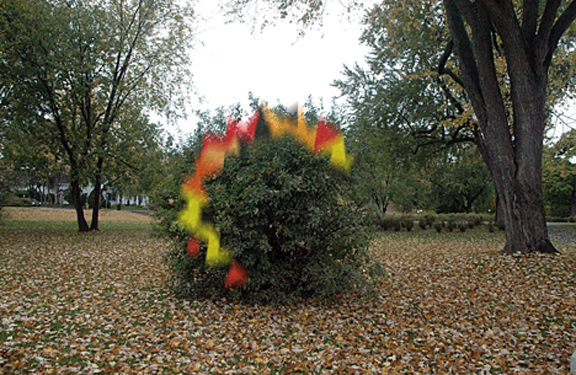
Below:
Artist's renderings of ocular arrays
acrylic on paper. 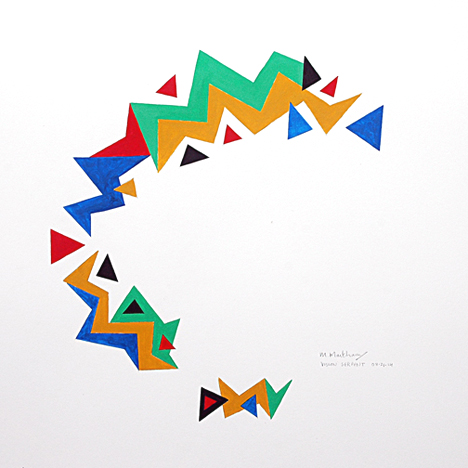
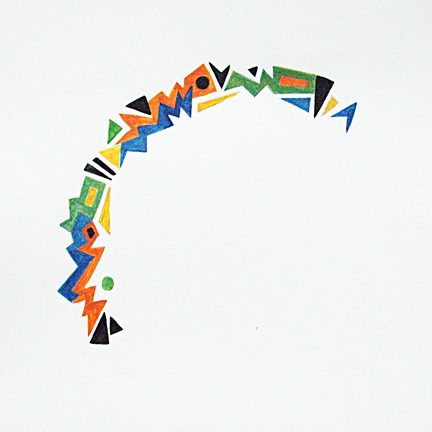
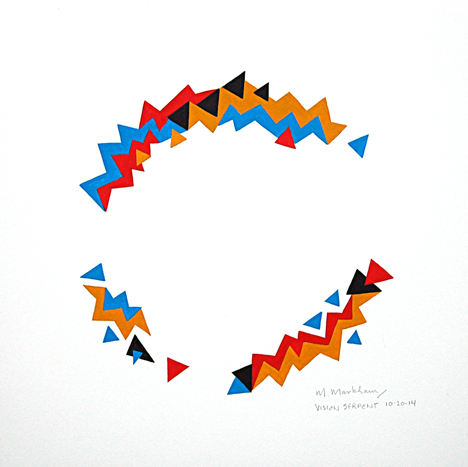
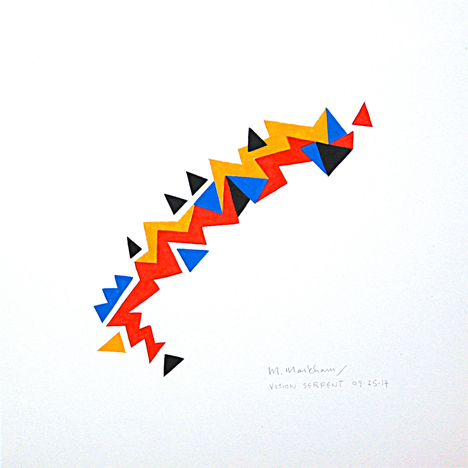
|
I get visual patterns projected onto my field of vision when I
have a migraine. They start small and surround the center of my view and then
expand outwards until they move out of my field of vision entirely. The process
takes about half an hour. I can't look directly at the pattern as it always
lies outside and around the focal point. These patterns are brightly colored,
translucent and they shimmer and shift — they are not static.
When these ocular migraines first began I experienced them in the workplace,
surrounded by all the visual noise and clutter of a busy corporate environment
(I was an art director at a publishing company). The first time it happened I
thought I might be having a stroke. I read up on them and found that it was a
form of migraine. I'd had severe migraines as a boy, but there was no pain to
this new phenomenon. Some time later I experienced one of these occurrences
while hiking in the woods — and this was an event that provoked some
interesting questions.
Within the woods the colors of this ocular event were much more vivid,
contrasting with the dark greens and browns of the natural world. It was less
of an annoyance and took on the character of an extraordinary event. I began
wondering whether ancient humans were susceptible to similar occurrences but,
unlike us, they surely wouldn't have had any idea what it was they were
experiencing. It must have seemed quite magical — even frightening.
In various cultures it was often a right of passage to go on a "vision quest"
as you matured into adulthood. For shamans this was an essential rite. As a
part of this procedure it was necessary to perform ritual acts that were
supposed to bring about the sought-after vision. Fasting (including refusing
water) and sleep deprivation were required — often for days. It therefore
intrigues me that my own ocular migraines come about most often because I
have have not eaten for some time, or I'm dehydrated, or I'm fatigued.
In his excellent book The Killing of Crazy Horse Thomas Powers writes of
a Lakota man known as Horn Chips (Ptehe Woptuha) who was told by the voice of
Wakan Tanka to go to a mountain top "and stay there four days with no food or
drink." Powers relates "Horn Chips did as the voice directed and was rewarded
with a dream in which a snake came to him with instructions." (Horn Chips was
to become the medicine man who interpreted the dreams of Crazy Horse and who
gave this great warrior the talismans from which he drew his power.)
In some cultures visions were sought by blood-letting, which would have brought
about fatigue and perhaps delirium. The shaman priests of the Mayans would draw
blood (often from their tongues or penises) and allow it to drip onto paper
which they would then burn. The smoke would rise and a "vision serpent" would
appear. Many writers have suggested that this vision serpent was represented by
the smoke itself, but I wonder if there wasn't more to it than that. Smoke by
itself is not an apparition, and the vision serpent was seen as a portal to the
Otherworld. Could this fatigue, brought on by the ritual bloodletting, have
provoked a vision of the kind I myself experience? Such a vision
shimmering brightly in the rising smoke would have seemed magical and could
have easily been interpreted as representing an Otherworldly presence. So,
while today we can perhaps explain them away, at one time these visions might
well have taken on religious and cultural importance.
As stated earlier, you can't focus on these patterns so they are not easy to
draw. You can perhaps give a simple impression: spirals, zigzags, dots, rays,
triangles and squares — all of these occur in my own ocular visions.
The overall appearance is somewhat (semi-) circular or spiral in form and
zigzag shapes run throughout. These are among the first forms that appear as
art in human culture. Sometimes they are simply scratched into bone or rock.
Later they are inscribed or painted onto pottery and, if you look at many
ancient pots, you see a circle of zigzags surrounding the opening. It seems
that these visual patterns became stylized into some of our most fundamental
abstract forms.
Ocular illusions and entoptic phenomena — which include such things as
floaters and "stars
before your eyes" and so on — are generally considered to have had a
connection to early abstract art but there seems to be much disagreement about
interpretation and how important this might have been to various prehistoric
cultures. Where the experts (David Lewis-Williams, Paul Bahn, and others) seem
to disagree most vigorously is over the connection to shamanic practices and
whether or not these visual events (and art) might have been connected to
ritual and religion. There is also the issue of hallucinogens being used to
provoke the visionary experience and the degree to which such drugs might have
been used. Going well back in time there is very little to go on, of course,
but marijuana has been found in the graves of ancient Eurasian shamans, and
peyote and other hallucinogens are known to have been used in the Americas. To
me it would seem that the visionary experience (whether linked to religion or
not) must go back to the earliest awakenings of human self-consciousness, and
explanation and meaning for these strange and intangible experiences would have
been needed. The very appearance of these visions — seemingly coming out
of nowhere — certainly must have seemed magical and other worldly. What
are they? Where do they come from? Why are they here?
My observations on the drug use issue would be two-fold:
a) My own "visions" are NOT drug induced but come about due to a chemical
imbalance caused by malnourishment and fatigue. Accordingly, ritual fasting or
blood-letting might well induce such visions without the need of drugs.
b) Even if drugs were used they might well have been restricted to a small
elite of shaman priests who could carry out the necessary rituals and interpret
the visions. In ancient cultures even beer was at first restricted to specific
cultural or ritual events. Tobacco was reserved for ritual use. Wine (and even
chocolate) was kept for special occasions. In our modern, secular society drugs
are considered abhorrent (maybe because they are out of place and out of
control) and perhaps their past usage in the rituals of ancient cultures is
being discounted or downplayed due to our current biases and distaste.
Much of this is speculative, of course — I'm not an academic and my
insights are based as much on intuition as on what I know with any certainty.
But I have labelled the interpretive representations of my own experience as
"vision serpents" because it seems an appropriate description of the patterned,
sensuous and shimmering patterns that appear to me. The deeper questions and
associations concerning how ancient humans would have seen and dealt with these
visions is something I'll continue to think about.
|
